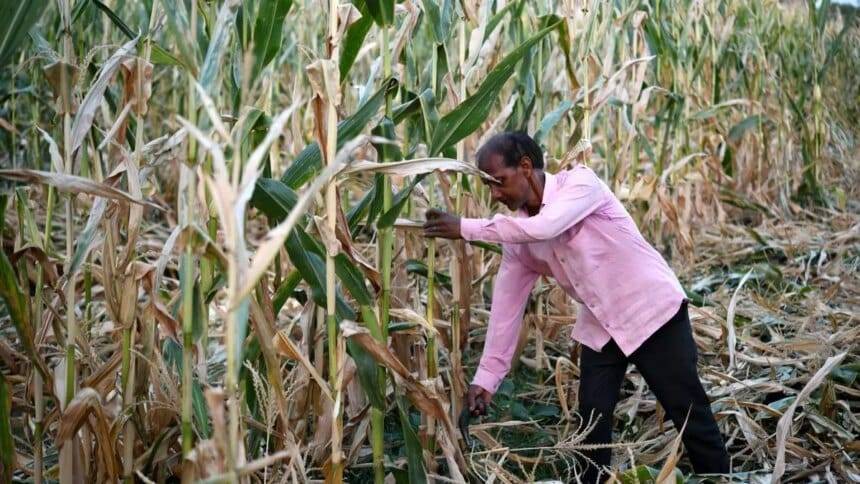Main Points In Hindi (मुख्य बातें – हिंदी में)
-
अफ्लाटॉक्सिन का प्रबंधन: भारतीय मक्का अनुसंधान संस्थान (आईआईएमआर) ने दावा किया है कि डीडीजीएस (सूखे डिस्टिलर अनाज) में अफ्लाटॉक्सिन के स्तर को 20 पीपीएम (पार्ट्स प्रति मिलियन) की अनुमेय सीमा तक कम करना संभव है, यदि उचित प्रौद्योगिकियों और कटाई के बाद की प्रथाओं का उपयोग किया जाए।
-
स्रोत पर नियंत्रण: डीडीजीएस में अफ्लाटॉक्सिन के स्तर को कम करने के लिए, आईआईएमआर ने सुझाव दिया है कि मेजबान संयंत्र प्रतिरोध और कृषि प्रबंधन का उपयोग किया जाना चाहिए, जिससे कीटों और फंगल संक्रमण को नियंत्रित किया जा सके।
-
परिवहन और भंडारण का प्रभाव: उचित प्रबंधन के माध्यम से, जैसे कि परिवहन और भंडारण के दौरान सावधानी बरतकर, डीडीजीएस की विषाक्तता को महत्वपूर्ण रूप से कम किया जा सकता है।
-
पशु आहार के लिए दिशानिर्देश: पशुपालन विभाग ने सुझाव दिया है कि जब तक डिस्टिलरी में अफ्लाटॉक्सिन के प्रबंधन की आवश्यकता नहीं होती, तब तक डीडीजीएस को मवेशियों के आहार में अधिकतम 10 प्रतिशत तक ही मिश्रित किया जाना चाहिए, ताकि स्वास्थ्य पर कोई नकारात्मक प्रभाव न पड़े।
- जागरूकता और अनुदान: आईआईएमआर ने बताया है कि विभिन्न हितधारकों के बीच डीडीजीएस और अफ्लाटॉक्सिन प्रबंधन के बारे में जागरूकता बढ़ाने की आवश्यकता है, और इसके लिए अनुमोदन सहित एक विशेष परियोजना की आवश्यकता है।
Main Points In English(मुख्य बातें – अंग्रेज़ी में)
Here are the main points from the article:
-
Aflatoxin Reduction in DDGS: The Indian Council of Agricultural Research (ICAR) states that it is possible to reduce aflatoxin levels in dried distillers grains with solubles (DDGS) to the permissible limit of 20 ppm through various technologies and post-harvest practices.
-
Role of Maize Research Institute: The Indian Institute of Maize Research (IIMR) emphasizes that managing aflatoxin levels can be achieved by utilizing host plant resistance and agricultural management practices at the source, especially concerning high moisture corn that is inadequately dried.
-
Proper Management during Transport and Storage: Effective management during transportation and storage can significantly decrease aflatoxin levels in DDGS, enhancing both protein content and safety for animal feed.
-
Mandatory Guidelines for DDGS Mixing: Due to health concerns, it is proposed that a maximum of 10% DDGS should be mixed into animal feed until issues are controlled by distilleries, ensuring safety for livestock and subsequent human consumption through dairy products.
- Need for Increased Awareness and Funding: There is a need for awareness among stakeholders about DDGS and aflatoxin management strategies. The IIMR suggests launching projects to address these concerns and secure funding for research to effectively manage aflatoxin in DDGS.


Complete News In Hindi(पूरी खबर – हिंदी में)
घुलनशील पदार्थों (डीडीजीएस) के साथ सूखे डिस्टिलर अनाज में एफ्लाटॉक्सिन के स्तर और इसके आयात के लिए फ़ीड उद्योग की बढ़ती मांग के बीच, आईसीएआर के मक्का अनुसंधान संस्थान ने कहा है कि स्तर को 20 पीपीएम (पार्ट्स प्रति मिलियन) की अनुमेय सीमा तक कम करना संभव है। ), विभिन्न प्रौद्योगिकियों और कटाई के बाद की प्रथाओं का उपयोग करना।
लुधियाना स्थित भारतीय मक्का अनुसंधान संस्थान (आईआईएमआर) के अनुसार, जिसके पास डिस्टिलरी उद्योग की मदद करने की विशेषज्ञता है, डीडीजीएस में एफ्लाटॉक्सिन के स्तर को कम करना संभव है यदि इसे स्रोत पर मेजबान संयंत्र प्रतिरोध और कृषि प्रबंधन का उपयोग करके प्रबंधित किया जाता है।
“इसके अतिरिक्त, परिवहन और भंडारण के दौरान उचित प्रबंधन विष के स्तर को काफी कम कर सकता है। उद्योग प्रोटीन सामग्री को बढ़ाने के साथ-साथ एफ्लाटॉक्सिन सामग्री को कम करने के लिए फ्रैक्शनेशन तकनीकों को भी लागू कर सकते हैं, ”पशुपालन विभाग द्वारा डीडीजीएस में एफ्लाटॉक्सिन पर चिंता जताए जाने के बाद आईआईएमआर ने केंद्र को एक संचार में कहा है, जिसका उपयोग पशु आहार के रूप में किया जाता है।
“जब तक इस मुद्दे को डिस्टिलरीज द्वारा नियंत्रित नहीं किया जाता है, तब तक पशु आहार में डीडीजीएस को अधिकतम 10 प्रतिशत तक मिश्रित करने के लिए एक अनिवार्य दिशानिर्देश की आवश्यकता होती है, ताकि भले ही 20 पीपीएम स्तर से अधिक डीडीजीएस मवेशियों के लिए हानिकारक न हो, न ही मानव के लिए। जब दूध का सेवन किया जाता है तो जनसंख्या बढ़ जाती है,” एक वरिष्ठ कृषि वैज्ञानिक ने कहा।
एफ्लाटॉक्सिन प्रबंधन
मई में एक निवेशक कॉल में, गोदरेज एग्रोवेट के प्रबंध निदेशक बलराम एस यादव ने कहा था कि अब भारत में अच्छी गुणवत्ता वाले डीडीजीएस का उत्पादन हो रहा है।
उच्च नमी स्तर वाले मक्के को यदि पर्याप्त रूप से नहीं सुखाया गया तो आम तौर पर फसल में एफ्लाटॉक्सिन का विकास होता है और ऐसे मक्के का उपयोग जब इथेनॉल के लिए भी किया जाता है, तो इसके उप-उत्पाद (डीडीजीएस) के भी प्रभावित होने की संभावना होती है।
आईआईएमआर ने कहा है कि डीडीजीएस के बारे में विभिन्न हितधारकों के बीच जागरूकता बढ़ाने की जरूरत है और सुझाव दिया है कि उत्पाद में एफ्लाटॉक्सिन प्रबंधन और पोषण वृद्धि और पशु चारा उद्योग की आशंकाओं को कम करने के लिए एक परियोजना की अनुमति दी जानी चाहिए।
जेनेटिक इंजीनियरिंग मूल्यांकन समिति (जीईएसी), डीडीजीएस के लिए आयात परमिट देने के लिए नियामक संस्था, ने 2019 में एक पैनल का गठन किया, जिसने आयात परमिट के लिए कई अनुरोधों के बाद, डीडीजीएस सहित पशु चारा आयात करने के लिए मसौदा दिशानिर्देश प्रस्तुत किए।
पशुपालन विभाग ने 2022 में, काउंटी में आयात किए जा सकने वाले पशु चारे की समेकित सूची जारी की और इसमें डीडीजीएस भी शामिल था। हालाँकि, चूँकि इसका अधिकांश भाग अमेरिका और ब्राज़ील में आनुवंशिक रूप से संशोधित मक्का से बनाया जाता है, इसलिए GEAC से परमिट की आवश्यकता होती है।
Complete News In English(पूरी खबर – अंग्रेज़ी में)
The Indian Institute of Maize Research (IIMR) has indicated that it is possible to reduce the level of aflatoxin in dry distiller grains with soluble (DDGS) to the acceptable limit of 20 parts per million (PPM) by utilizing various technologies and post-harvest practices. This comes in light of the growing demand from the feed industry for the safe import of DDGS.
According to IIMR, which has expertise in supporting the distillery sector, it is feasible to lower aflatoxin levels in DDGS if managed from the source by using resistant plant varieties and good agricultural practices. Proper management during transportation and storage can significantly reduce toxin levels as well. The institute also noted that the industry can employ fractionation techniques to increase protein content while decreasing aflatoxin levels in the DDGS used for animal feed.
A senior agricultural scientist mentioned that until distilleries effectively manage aflatoxin levels, there should be a mandatory guideline capping the inclusion of DDGS in animal feed to a maximum of 10%. This ensures that even if the DDGS exceeds the 20 PPM level, it is unlikely to harm livestock or humans, especially when milk consumption is considered.


In a recent investor call, the Managing Director of Godrej Agrovets stated that India is now producing high-quality DDGS. Aflatoxin typically develops in corn with high moisture levels if not dried adequately, which can also affect the by-products (DDGS) used in ethanol production.
IIMR has stressed the need to raise awareness among various stakeholders about DDGS and suggested initiating a project focused on aflatoxin management and nutritional enhancement to alleviate concerns in the animal feed industry.
The Genetic Engineering Appraisal Committee (GEAC), the regulatory body responsible for granting import permits for DDGS, established a panel in 2019 following multiple requests for import permits. The panel drafted guidelines for importing animal feed, including DDGS. In 2022, the animal husbandry department released a consolidated list of animal feed that can be imported into the country, which included DDGS. However, since most of it is derived from genetically modified corn from the USA and Brazil, a permit from GEAC is still required.
Source link




